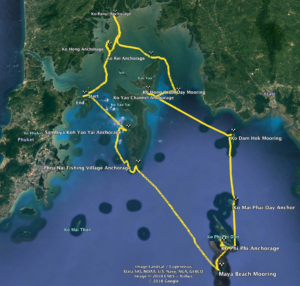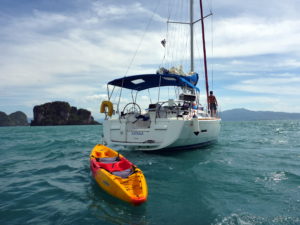…and suggestions…
This article is about bareboat cruising in Thailand; specifically discussing destinations and preparing for the challenges. But first here’s why Thailand should be on your short list of bareboat charter destinations:
Thailand, specifically Phang Nga (fang-na) Bay, is considered a challenging Bareboat charter destination. This isn’t because the wind howls; instead it is because the charts are coarse, the tides are tricky, the currents are strong, and the water is shallow and opaque. This video will familiarize you with the area and prepare you for the challenges so you can better enjoy this destination.
Sunday: Tides & Depths

Sunday we made our way from Ao Po Grande marina to Ko Hong. To explore the island we needed to transit a vast 2-5 meter contour on the chart. Given our 2 meter draft these weren’t the best circumstances to get acquainted with the nearly 3 meter tidal range.
Ko Hong was definitely a worthwhile stop. We saw our first Hongs – exploring with the hordes of tourists in the afternoon and with the whole place to ourselves leading up to the sunset. Our dinghy and kayak became vehicles of exploration in the shallow, narrow, cliff lined waters. Impressed by these first Hongs we vowed to see as many hongs as possible.
Ko Hong was also a great place to observe the tidal range and its effects. The tidal range was carved into the base of every cliff. Waterways we traversed early in the day turned into beaches as the tide receded. Tunnels leading to Hongs alternately flooded to the ceiling and dried out. Observing the tide at Ko Hong we determined that the tide timing we had looked up before the trip was off by about two hours.
The hardest lesson came the next morning as we tried to traverse a 2-5 meter contour at first light, near low tide. When the depth on the sounder read 0.1 meters we spun the boat around and took the long way instead of waiting for the tide to flood back in.
Monday: Currents and Swimming
Our next stop was the fishing village of Ko Panyi. We anchored bow into the wind and watched the chain pay out under the hull; in the deep water anchorage the current from the tide flooding in was much stronger than the opposing breeze.
Our stay at Ko Panyi was brief because the lunch rush flooded in on speedboats with no regard for their wakes. This momentarily quiet fishing village became a bustling food court for speedboat toursists.
Having learned from our anchorage at Ko Panyi upon arriving at Ko Roi we checked our drift before anchoring. We dropped the hook with the stern to windward and the bow pointed into the current.
Ko Roi was an good anchorage to explore by dinghy and kayak. As long as you aren’t afraid of bats…
The second challenge of Phang Nga bay is strong currents. Besides making anchoring more difficult Ko Roi had enough current in the anchorage that it was dangerous to swim off the boat. One of our crew jumped off the stern of the boat to cool off but was unable to swim back to the boat because of the current. We had to use the dinghy to rescue her. Be very careful swimming in Thailand: the currents can be strong and dangerous.
Tuesday: Wind Shadows and Compression zones
We got an early start on Tuesday so that we’d have wind for sailing. In our experience the Northeast monsoon season meant the northeasterlies built overnight and were strongest in the morning; before they were contradicted by the building southwest sea breeze. All the sailing we did on our charter happened in the morning.
Our first anchorage was Ko Hong Krabi. This was another popular tourist destination bolstered by its accessibility via Long tail boat. The many wakes and beautiful cliffs near the mooring field made it a choppy compression zone. Skippers need to make accommodations for the compression zones and large wind shadows of the towering cliffs Phang Nga Bay.
Our overnight anchorage was at the fishing village of Ko Yai Noi.
Wednesday: Small fishing villages are great for provisions
The fishing village at Ko Yao Noi, along with all the other villages we encountered, had everything a charterer needed; but especially ice. With the 80 degree water and 90 degree air without ice our “refrigerator” on board was more cool than cold. Ice was plentiful because ice is how things were kept cold ashore as well as aboard. They also kept lots of bottled water on hand.
After stocking up on ice and exploring the town we we motored upwind to Ko Dam Hok. At Ko Dam Hok there were the usual caves plus a beach and some snorkeling.
We were on moorings for the night. The moorings had us spending the night all but underneath the cliffs – this was my favorite overnight spot because of the cliffs above and the cooling breeze, accelerated by the cliff overhead, on deck:
Thursday: Water visibility
We arose early on Thursday so that we could sail to more snorkelling at Bamboo island; we hoisted sail as soon as we got out of the wind shadow of the cliffs.
The further south we got the clearer the water became. We anchored on the weather side of the reef in 10m of water and I could see the bottom. Four days before in Ko Hong I couldn’t see my feet in knee deep water.
The clearer water was a mixed blessing because you could see all of the jellyfish in the area. One person on our boat got stung for sure – the cruising guide had instructions for treating stings and the boat had extra sting treatment supplies. Jellyfish are a way of life in Phang Nga Bay.
Sure enough we had to motor to Ko Phi Phi in the afternoon as the sea breeze countered the Northeasterlies.
Ko Phi Phi is worth checking out at least for one night:
Friday: Hazards and ATONs
Friday we got up early to check out Maya Bay. It was a bit of a let down: already crowded even though we arrived early and quite lackluster compared to the places we’d already been. Though it did have some interesting places to explore by kayak.
On the long passage to Ko Yao Yai we finally got to see the fishing boats whose bright lights light up the horizon at night. The fishing boats use bright constant lights to attract squid; these lights can be seen for miles. Instead of navigation lights you’ll find that vessels underway or anchored at night display a single colored strobe without sectors. Fishing traps are not lit. I don’t recommend navigating at night unless absolutely necessary.
During the day don’t get in between vessels dragging a net between them and you should be fine.
The village on the southern tip of Ko Yao Yai was very cool. It was the only village with navigation aids of any kind; including a bright light on the end of their pier that functioned as a lighted aid to navigation.
Saturday: Get the Kayak

The last day of the trip we started with a team breakfast. I always enjoy the creative treats we come up with as provisions run low are always delicious.
Then we had a short sail over to the Santhiya resort. We enjoyed their beach, pool and buffet dinner.
The kayak spent the day on deck; which was unusual. The kayak proved a great way to explore Thailand’s unique coastline. If I had it to do over again I would have gotten a second kayak!
Summary
Phang Nga Bay has significant tide and current in opaque waters; it’s like navigating a coarsely charted New England without aids to navigation. The geography has a lot of impact on the sailing conditions creating wind shadows and compression zones.
These challenges impact you when you’re not on the boat too; the tides submerge beaches and cave passages; the currents are too strong to swim against and come right up to shore. Also Jellyfish.
Still the trip was totally worth it. Unique scenery, towns from a time past and the friendliest locals I’ve ever encountered.
Questions? Ask away in the comments! I hope you found this write up helpful. See you out there!
Hi Savvy Salt, I currently live and work in Shanghai, China. I thinking about taking a IYT Bareboat Skipper Certification course in Thailand with a sailing school. Most sailing schools in Thailand offer a 10 day IYT Bareboat Skipper Certification with a pre-training online course called the NauticEd Online Sailing Theory course. Will I be more prepared to pass the written examination and the continuous practical examination in these 10 day courses? Also, I am an American citizen, so does is the IYT Bareboat Skipper Certification accepted in the US and in the Caribbean? I am comfortable around water as I have taken a PADI Scuba Diver Certification course in Koh Phangan in Thailand. Thanks!
I’ve never heard of IYT bareboat. I’ve also never heard of it being accepted by charter operations or boat clubs in the US. US club and charter operations sometimes accept ASA certs, US sailing certs or (rarely) both. Some don’t accept either and have their own checkout/test procedure.
Many operations in the Caribbean only require a simple sailing resume http://savvysalt.com/blog/steps-to-make-your-bareboat-charter-a-resounding-success/#bareboat-charter-resounding-success-qualified-on-paper
Just to clarify: the NauticEd Online Sailing Theory course is an option to help prepare for the IYT 10 day (liveaboard?) course? And you’re wondering if you should opt for the NauticEd course? That is probably most dependent on your learning style; I recommend that you try out the free NauticEd courses and see how they work for you before you decide: http://www.nauticed.org/two-free-sailing-courses